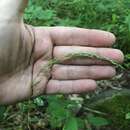Comprehensive Description
provided by North American Flora
Sphenopholis intermedia (Rj'db.) Rydb. Bull. Torrey Club
36:533. 1909.
Koeleria truncata var. major Torr. Fl. U. S. 117. 1823. (Type from Dcerfield, Massachusetts, Coolcy.)
Koeleria? pennsyhanica var. major Torr. Fl. N. Y. 2; 469. 1843. (Based on Koeleria truncata var. major Torr.)
Reboidea pennsyhanica var. major A. Gray, Man. 591. 1848. (Presumably based on Koeleria truncata var. major Torr.)
?.A»>a coH(rofer5a Steud. Syn. Gram. 224. 1854. (Type from Ohio.)
Eatonia pennsyhanica var. major A. Gray, Man. ed. 2. 558. 1856. (Presumably based on Koeleria truncata var. major Torr.)
Vilfa alba Buckl. Proc. Acad. Phila. 1862: 89. 1862. (Type from "Oregon, Spalding"). Not V. alba Beauv. 1812.
Eatonia intermedia Rydb. Bull. Torrey Club 32: 602. 1905.
Sphenopholis pallens major Scribn. Rhodora 8: 145. 1906. (Based on Koeleria truncata var. major Torr.)
Reboulea pallens var. major Farwell, Rep. Mich. Acad. 17: 182. 1916. (Based on Koeleria truncata var. major Torr.)
Culms erect, in small tufts, slender, glabrous, sometimes scabrous below the panicle, 30-120 cm. tall; sheaths glabrous or scabrous or pubescent; Hgule 1-3 mm. long, truncate, erose-dentate; blades flat, often elongate, lax, mostly scaberulous, occasionally sparsely pilose, mostly 2-6 mm. wide, sometimes wider; panicle nodding, from rather dense to open, mostly 10-20 cm. long, the axis more or less scaberulous, the branches very slender, scabrous, spikeletbearing from near the base; spikelets 3-4 mm. long, the rachilla between the 2 florets about 1 mm. long; first glume very narrow, shorter than the second; second glume relatively thin, acute or subacute, about 2.5 mm. long; lemmas subacute, rarely mucronate, smooth or rarely very minutely roughened, greenish at apex, mostly 2.5-3 mm. long; palca thin, narrow, a little shorter than the lemma.
Type locality: East Gallatin Swamps, Montana, Rydberg 3174.
Distribution: Damp or rocky woods, slopes, and moist places, Newfoundland to British Columbia, and southward to Florida and Arizona; Tanana Hot Springs, Alaska.
- bibliographic citation
- Albert Spear Hitchcock, Jason Richard Swallen, Agnes Chase. 1939. (POALES); POACEAE (pars). North American flora. vol 17(8). New York Botanical Garden, New York, NY
Comprehensive Description
provided by North American Flora
Sphenopholis longiflora (Vasey) Hitchc. Jour. Wash. Acad
23:453. 1933.
Eatonia pennsyhanica var. longiflora Vasey; L. Dewey, Contr. U. S. Nat. Herb. 2: 544. 1894. Eatonia longiflora Beal, Grasses N. Am. 2: 494. 1896. (Based on Eatonia pennsyhanica var.
longiflora Vasey.) Sphenopholis pallens longiflora Scribn. Rhodora 8: 145. 1906. (Based on Eatonia pennsyhanica var.
longiflora Vasey.) Reboulea pallens var. longiflora Farwell, Rep. Mich. Acad. 17: 182. 1916. (Based on Eatonia longiflora Beal.)
Culms relatively stout, erect from a decumbent base, glabrous, 40-70 cm. tall; lower sheaths puberulent, the others glabrous; ligule truncate, erose-dentate, 1-2 mm. long; blades thin, flat, scaberulous, 5-18 cm. long, 3-8 mm. wide; panicle many-flowered, rather loose, slightly nodding, 10-18 cm. long, the axis glabrous, the branches very slender, somewhat flesuous, scabrous, the primary branches as much as 5 cm. long, naked below; spikelets mostly 2-flovered, 4.5-5 mm. long, the rachilla appressed-pilose, 1.3-1,5 mm. long; glumes very scabrous on the green part, about equal in length, the first very narrow, the second thin, acute, about 3.5 mm. long, the hyaline margin broad; lemmas smooth, scaberulous toward the tip, the first about 4 mm. long; palea much shorter than the lemma, the upper bowed out.
Type locauty; Houston, Texas (Nealley in 1892). Distribution: Known only from the type locality.
- bibliographic citation
- Albert Spear Hitchcock, Jason Richard Swallen, Agnes Chase. 1939. (POALES); POACEAE (pars). North American flora. vol 17(8). New York Botanical Garden, New York, NY
Physical Description
provided by USDA PLANTS text
Annuals, Perennials, Terrestrial, not aquatic, Stems nodes swollen or brittle, Stems erect or ascending, Stems caespitose, tufted, or clustered, Stems terete, round in cross section, or polygonal, Stem internodes hollow, Stems with inflorescence less than 1 m tall, Stems with inflorescence 1-2 m tall, Stems, culms, or scapes exceeding basal leaves, Leaves mostly basal, below middle of stem, Leaves mostly cauline, Leaves conspicuously 2-ranked, distichous, Leaves sheathing at base, Leaf sheath mostly open, or loose, Leaf sheath smooth, glabrous, Leaf sheath hairy, hispid or prickly, Leaf sheath and blade differentiated, Leaf blades linear, Leaf blades 2-10 mm wide, Leaf blades mostly flat, Leaf blades mostly glabrous, Leaf blades more or less hairy, Leaf blades scabrous, roughened, or wrinkled, Ligule present, Ligule an unfringed eciliate membrane, Inflorescence terminal, Inflorescence an open panicle, openly paniculate, branches spreading, Inflorescence solitary, with 1 spike, fascicle, glomerule, head, or cluster per stem or culm, Inflorescence lax, widely spreading, branches drooping, pendulous, Flowers bisexual, Spikelets pedicellate, Spikelets laterally compressed, Spikelet less than 3 mm wide, Spikelets with 2 florets, Spikelets with 3-7 florets, Spikelets solitary at rachis nodes, Spikelets all alike and fertille, Spikelets bisexual, Spikelets disarticulating below the glumes, Spikelets disarticulating beneath or between the florets, Rachilla or pedicel hairy, Glumes present, empty bracts, Glumes 2 clearly present, Glumes distinctly unequal, Glumes shorter than adjacent lemma, Glumes equal to or longer than adjacent lemma, Glumes keeled or winged, Glumes 1 nerved, Glumes 3 nerved, Lemma similar in texture to glumes, Lemma 5-7 nerved, Lemma glabrous, Lemma apex acute or acuminate, Lemma awnless, Lemma mucronate, very shortly beaked or a wned, less than 1-2 mm, Lemma margins thin, lying flat, Lemma straight, Palea present, well developed, Palea membranous, hyaline, Palea shorter than lemma, Palea 2 nerved or 2 keeled, Stamens 3, Styles 2-fid, deeply 2-branched, Stigmas 2, Fruit - caryopsis.
Sphenopholis intermedia: Brief Summary
provided by wikipedia EN
Sphenopholis intermedia, the slender wedgegrass or slender wedgescale, is an annual grass native to North America. The specific epithet "intermedia" means "intermediate". The diploid number is 14.
- license
- cc-by-sa-3.0
- copyright
- Wikipedia authors and editors

